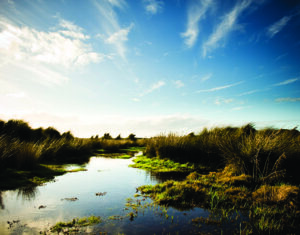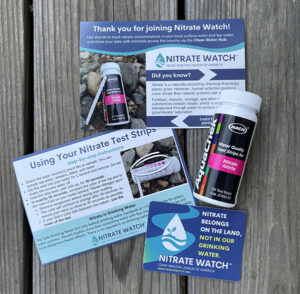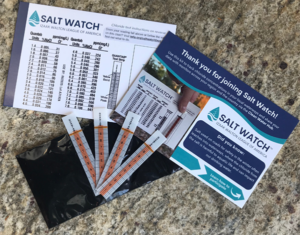Volunteers Navigate a Bureaucratic Maze to Stop Dangerous Pollution
Karen Daponte Thornton, Little Falls Watershed Alliance
In late December 2024, the Montgomery County, Md., Department of Environmental Protection (DEP) proclaimed big news on Facebook:
“Huge shoutout to the DEP Water Monitoring team…for their amazing work tracing and stopping a fecal contamination, issue! The team identified the source—an illicit plumbing hook-up in a downtown Bethesda building that was sending fecal matter into a nearby creek through the storm drain system. Thank you Delegate Marc Korman, Little Falls Watershed Alliance and Citizen Scientists for their ongoing stream testing! Without their dedication and vigilance, this contamination would have gone undetected.”
It takes persistence to turn a stewardship mission into reality. This is the story of the Little Falls Watershed Alliance’s (LFWA) dedication and vigilance. LFWA’s mission is to speak up for parks and natural areas and bring neighbors together in Montgomery County, Maryland and adjacent Washington, DC communities to build awareness, improve habitat and enhance the enjoyment of the creeks and forests in the watershed.
The challenge began in 2009, when several local watershed groups took the Washington Suburban Sanitary Commission (WSSC) to court because of evidence of sewage leaks. Sanitary pipes that were buried under the streams were thought to be broken and leaking into the water.
A court decree required WSSC to test waterways in Montgomery County and make the data public. Then in 2014, WSSC began a massive pipe relining effort based on where their testing showed leaks. Three leaks were within the Little Falls watershed.
The key contaminant measured is E. coli. According to the EPA, Escherichia coli (E. coli) represent about 97 percent of all the coliform bacteria in human feces, which makes this an excellent indicator of fecal contamination.
In 2020, as follow up to questions about water quality, LFWA took the initiative to conduct water quality testing above and below the leak spots to confirm whether they’d been fixed. Three LFWA board members went out to five locations over two weeks to test the water quality, including for the presence of E. coli, and published a modest report of their results. LFWA did testing because no one else was.
Testing reveals scary numbers
During COVID, in 2021, LFWA leveraged the availability of neighbors seeking respite in nature during the pandemic and we learned how to organize citizen scientists to gather data and report results. We started testing in earnest at eight sites on two streams with a group of self-organized volunteers, including one super-volunteer, Woody Stanley, who developed a dashboard for our website to post the results. The team used the Anacostia Riverkeeper Lab to process results.
The following year, we hired our first intern, an American University graduate student, and started charting real numbers for E. coli contamination. Scary numbers, for purposes of public safety. LFWA tested a total of seven sites within the watershed— five sites within on the Little Falls Branch and two sites on the Willett Branch.
While all of the sites had E coli numbers regularly above the 410 MPN threshold for safe water play, one site on the Willett Branch had numbers exceeding 24,000 MPN. MPN refers to a measurement called the most probable number method that is a count of bacteria per 100 ml. An unflushed toilet is typically
about 300/100 ml.
LFWA funded the intern and all testing through support from private donors.
Raising awareness and alarm
To inform neighbors of the health hazards that could arise from wading and playing in the Willet Branch, LFWA posted data to our website in the form of charts and graphics. But we didn’t stop there. Executive Director Sarah Morse started a major public awareness campaign, sending a weekly email with test results to over a dozen community listservs as well as local elected officials and government workers, reaching more than 50,000 people each week. Every week, volunteers posted signs at key recreational areas along the creeks to let people know the fecal status before jumping in.
Neighbors took notice and asked for DNA testing, which showed the source of the e coli contamination was human. Private donor support increased, but no elected officials or government agency seemed to take notice, with the exception of State Delegate Marc Korman. Korman has described his collaboration with LFWA as 2.5 years of navigating “a lot of bureaucratic hoops.” He explained how proud he was to “work in partnership with LFWA to push and drive action across various agencies and organizations.”
Getting to the bottom of the problem
Based on the history of sewer pipe leaks, LFWA assumed the culprit was a broken sewer line, so Korman helped set up a meeting with WSSC. Turns out, this wasn’t a sewer line leak after all. It was worse. A totally preventable error.
In Montgomery County, wastewater from toilets goes to the sanitary treatment facility and stormwater run-off goes to the creek. So, when plumbing is installed in a building, care must be taken to ensure that the wastewater isn’t being connected into the storm drainpipes. If the pipes are improperly connected, the wastewater goes to the storm drain system where it runs directly to the creek.
On a community Zoom call hosted by the Department of Environmental Protection, Morse spoke up about the high bacteria counts and complained that her calls were not being answered. The DEP promised to follow up. They even posted official warning signs along the creek.
And true to their word, DEP spent 18 months trying to find the source. Why did it take so long?
The drainage area for the stream is huge. It’s over a mile of underground piping between the Willett Branch where we tested the creek for fecal matter and the building in downtown Bethesda where the toilets were dumping into the storm drain system so they had a lot of ground to cover before finding the illicit hook-up.
Partnership, persistence pay off
The County tests for illicit or improper sewer hook-ups by putting dye into the toilets. If they see the dye in the storm water drain system, they know there is a problem. They also pull the storm drain covers in dry weather. If there is water in the storm drain, that suggests an illicit hook-up. In this case, there were hundreds of storm drains to check and thousands of possible toilets.
By luck, DEP were able to narrow down the source by finding a pipe that was discharging waste into the storm drain. They were then able to send cameras down the pipe to see where the fecal matter was entering the system. Once they identified the building, the dye testing was done to confirm the illicit hook up.
So after years of persistence, hundreds of hours of volunteer water testing and a bit of luck, the mystery was solved.
This complex pollution mystery led volunteer scientists and professionals down many literal holes—as well as legal, scientific and bureaucratic ones. And the persistence paid off. Like us, you may have to blaze your own trail to solve a similar mystery. And do your community a big favor by stopping pollution at the source.
Karen DaPonte Thornton serves as president of the volunteer board for the Little Falls Watershed Alliance. She grew up playing in the Little Falls Branch and moved back to the area to start her own family and share the watershed wonders with her children.

 Your kit will include a bottle containing 25 nitrate test strips which you can use to test your water source(s) throughout the year. You’ll also receive postcards explaining how to use your nitrate test strips and how to share your Nitrate Watch results on the Clean Water Hub.
Your kit will include a bottle containing 25 nitrate test strips which you can use to test your water source(s) throughout the year. You’ll also receive postcards explaining how to use your nitrate test strips and how to share your Nitrate Watch results on the Clean Water Hub. Your kit will include four test strips so you can test your waterway throughout the season. You’ll also receive a chart to help you interpret your results and a postcard with instructions for completing a Salt Watch test and reporting your findings.
Your kit will include four test strips so you can test your waterway throughout the season. You’ll also receive a chart to help you interpret your results and a postcard with instructions for completing a Salt Watch test and reporting your findings.